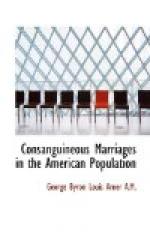Same-name first cousin marriages 1 ------------------------------------- = --- Different-name first cousin marriages 3
Here too, he fears that the denominator is too small, for by theoretical calculation he obtains by one method the ratio 2/7, and by another 1/1. He finally takes 1/4 for this factor. To express the proportion in another form:
Same-name first cousin marriages 1 -------------------------------- = --- All first cousin marriages 5
The completed formula then becomes:
All same-name marriages 100 1 -------------------------- = ----- X --- = .35 (nearly) All first cousin marriages 57 5
Applying this formula to the English statistics, Mr. Darwin computes the percentages of first cousin marriages in England with the following results:
--------------------------------------- London | 1.5 Other urban districts | 2. Rural districts | 2.25 Middle class and Landed Gentry | 3.5 Aristocracy | 4.5 ---------------------------------------
In order to apply this formula to the American population I counted the names in the New York Marriage License Record previous to 1784,[25] and found the number to be 20,396, representing 10,198 marriages. The fifty commonest names embraced nearly 15 per cent of the whole (1526), or three per cent less than the number found by Darwin.[26] Of these, one in every 53 was a Smith, one in 192 a Lawrence, and so on. The sum of the fraction 1/53^2, 1/192^2, etc., I found to be .000757 or .757 per thousand, showing that the probability of a chance marriage between persons of the same name was even less than in England, where Mr. Darwin considered it almost a negligible quantity.
[Footnote 25: Names of Persons for whom Marriage Licenses were issued by the Secretary of the Province of New York.]
[Footnote 26: Cf. supra, p. 21.]
Of these 10,198 marriages, 211, or 2.07 per cent were between persons bearing the same surname. Applying Darwin’s formula we would have 5.9 as the percentage of first cousin marriages in colonial New York. This figure is evidently much too high, so in the hope of finding the fallacy, I worked out the formula entirely from American data. To avoid the personal equation which would tend to increase the number of same-name first cousin marriages at the expense of the same-name not first cousin marriages, I took only those marriages obtained from genealogies, which would be absolutely unbiassed in this respect. Out of 242 marriages between persons of the same name, 70 were between first cousins, giving the proportion:
Same-name first cousin marriages 70 -------------------------------- = --- = .285 All same-name marriages 242
as compared with Darwin’s .57. So that we may be fairly safe in assuming that not more than 1/3 of all same-name marriages are first cousin marriages. Taking data from the same sources and eliminating as far as possible those genealogies in which only the male line is traced, we have it:




